
| Genus List | Genus overview |Species List |
10a. Basal margin of mandible with notch, formed by sinuous indentation of basal margin and small denticle on proximal edge of notch; size usually small (WL about 1mm or less), only rarely larger: 20
10b. Basal margin of mandible flat, without a notch; size variable but often larger: 35

20a. Face with faint to strong sculpture over most of surface, but usually not with a combination of (1) highly smooth and polished posterior surface and (2) a fan of diverging subparallel rugae between the frontal carinae; size small, WL usually less than 1mmm; in full face view, anterior clypeal margin with convex median lobe that extends to or beyond lateral clypeal teeth, downturned portion of anterior clypeus straight between lateral teeth, without indentation or median teeth; common: 30
20b. Face with combination of highly smooth and polished posterior surface and a fan of diverging subparallel rugae between the frontal carinae; size large, WL 1.24mm; in full face view, anterior clypeal margin emarginate medially, downturned portion with two small median teeth between lateral teeth; rare: JTL-018

30a. Erect setae on mesomal dorsum and first gastral tergite moderately to strongly stiffened; first gastral tergite lacking abundant appressed pubescence beneath erect setae: JTL-006
30b. Erect setae on mesosomal dorsum and first gastral tergite thin and flexuous; first gastral tergite usually with abundant appressed pubescence: schmidti
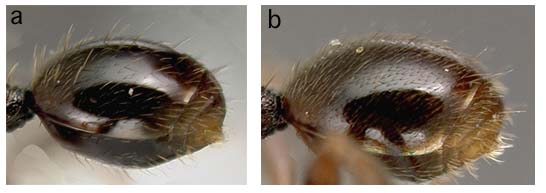
35a. In full face view, anterior clypeal margin with convex median lobe that extends to or beyond lateral clypeal teeth, downturned portion of anterior clypeus straight between lateral teeth, without indentation or median teeth; WL about 1mm or less: JTL-006 (Osa population)
35b. In full face view, anterior clypeal margin variable but often distinctly emarginate, not extending beyond lateral clypeal lobes or teeth, downturned portion with median notch and/or pair of median teeth between lateral teeth; size variable but often larger: 40
40a. Face and/or mesosoma strongly sculptured, either strongly rugose or strongly foveate, if face smooth and shiny posteriorly, then mesosoma irregularly rugose over entire surface; and propodeum with distinct angle or small tooth separating dorsal and posterior faces: 50
40b. Face and mesosoma not strongly sculptured; or dorsal face of propodeum rounds into posterior face, not forming distinct angle or tooth: 80
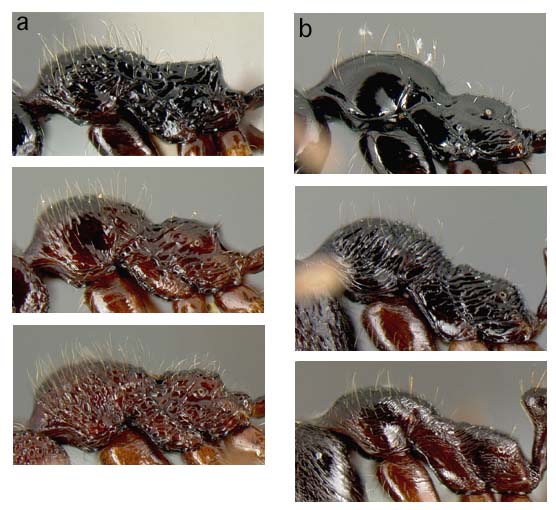
50a. Face uniformly foveolate; anterior margin of clypeus with broad rectangular notch, about as broad as anterior projections of frontal lobes, outer edges of notch forming angular teeth: 60
50b. Face with irregular rugae anteriorly, smooth and shiny posteriorly; anterior margin of clypeus sinuous, with rounded medial notch, notch narrower than anterior projections of frontal lobes: 70

60a. Entire side of head and side of mesosoma foveolate; postpetiolar dorsum in lateral view evenly convex: JTL-011
60b. Upper sides of head with a smooth patch; side of mesosoma less regularly foveolate, more irregularly rugose, generally smoother and shinier; postpetiolar dorsum in lateral view somewhat differentiated into dorsal and posterior faces, posterior face slightly concave: JTL-012
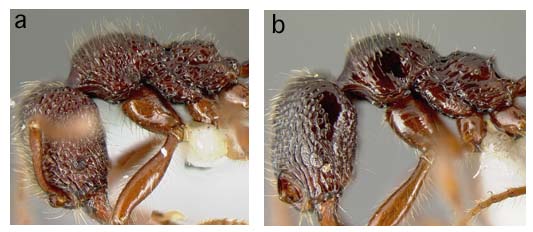
70a. Side of petiolar peduncle and lower side of petiolar node punctate; metapleural lobe rounded: JTL-010
70b. Side of petiole smooth and shiny; metapleural lobe strongly produced and angular: JTL-015

80a. Mesosoma and at least posterior portion of face smooth and highly polished, with reflective surfaces: 90
80b. Mesosoma and face faintly or strongly sculptured, without smooth and highly reflective surface: 100
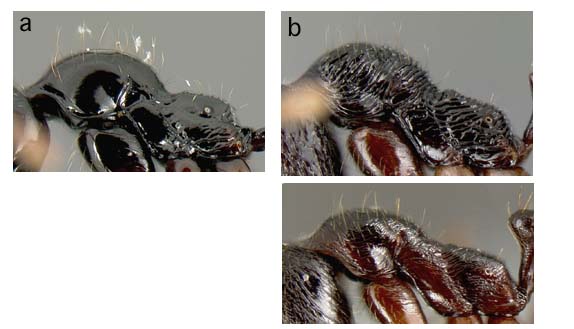
90a. Face almost entirely smooth, with at most a few short longitudinal rugae between frontal lobes and short rugae extending from mandibular insertions to about level of compound eye, never beyond; legs black: expolitum
90b. Face with a distinct fan of longitudinal rugae between frontal lobes, and rugose sculpture extends from mandibular insertions to beyond compound eye; legs black or red brown: 95
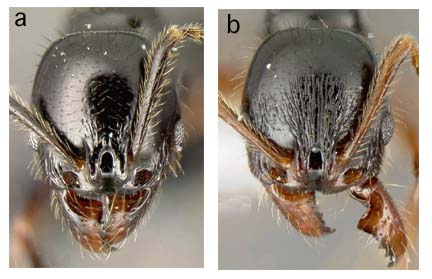
95a. Side of propodeum largely smooth and shining, with at most one longitudinal rugule; juncture of dorsal and posterior face of propodeum with a weak transverse carina; legs dark red brown: JTL-019
95b. Side of propodeum with several rugulae; juncture of dorsal and posterior face of propodeum sharper, marked by a distinct transverse carina; legs lighter red brown: alas
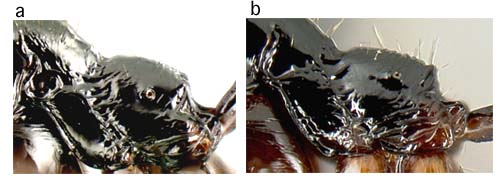
100a. Face and mesosoma strongly sculptured; WL greater than 1mm: felixi
100b. Face and mesosoma weakly sculptured; WL about 1mm: JTL-017

Page author:
John T. Longino, The Evergreen State College, Olympia WA 98505 USA.longinoj@evergreen.edu